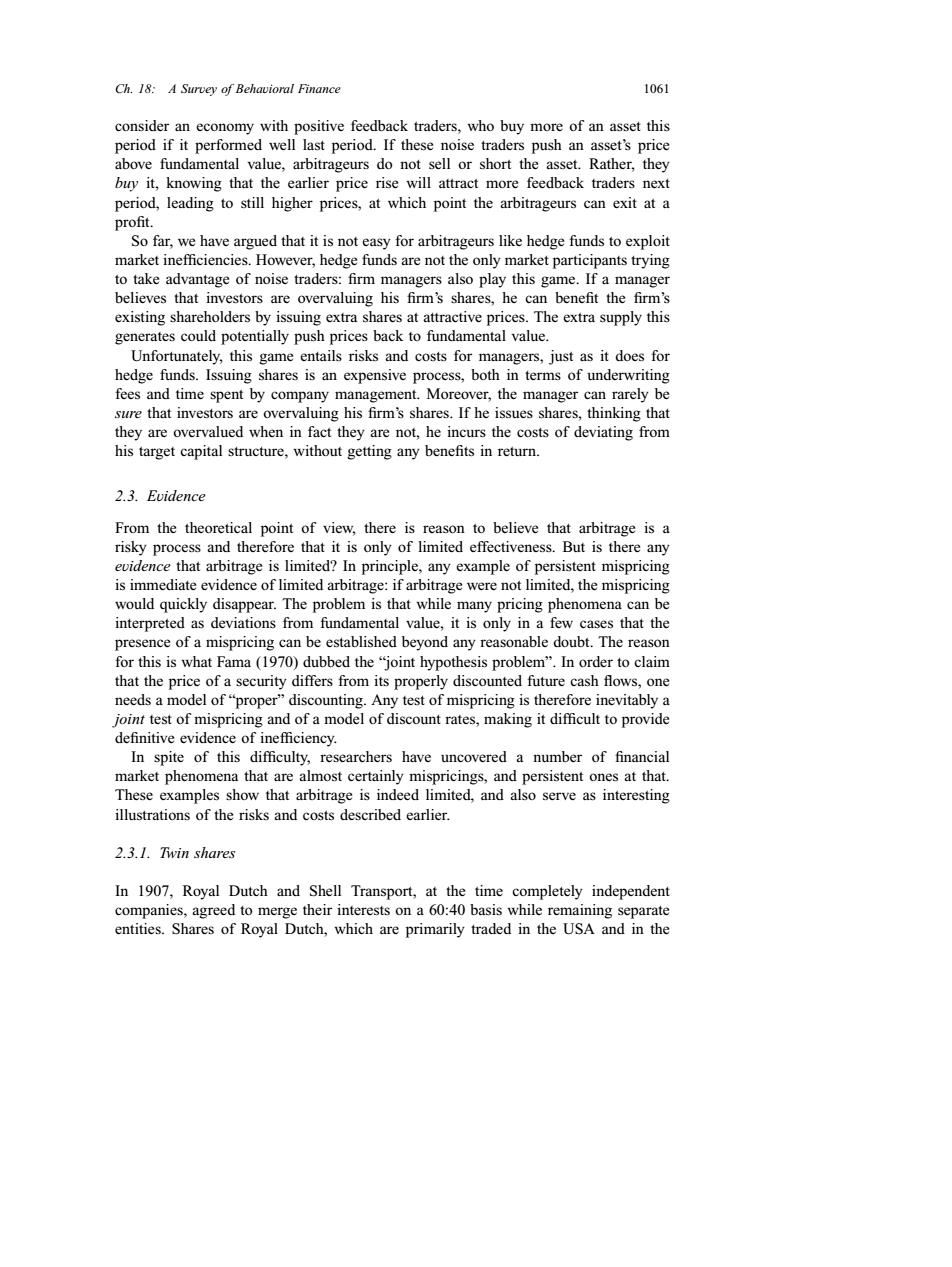正在加载图片...

Ch.18:A Survey of Behavioral Finance 1061 consider an economy with positive feedback traders,who buy more of an asset this period if it performed well last period.If these noise traders push an asset's price above fundamental value,arbitrageurs do not sell or short the asset.Rather,they buy it,knowing that the earlier price rise will attract more feedback traders next period,leading to still higher prices,at which point the arbitrageurs can exit at a profit. So far,we have argued that it is not easy for arbitrageurs like hedge funds to exploit market inefficiencies.However,hedge funds are not the only market participants trying to take advantage of noise traders:firm managers also play this game.If a manager believes that investors are overvaluing his firm's shares,he can benefit the firm's existing shareholders by issuing extra shares at attractive prices.The extra supply this generates could potentially push prices back to fundamental value. Unfortunately,this game entails risks and costs for managers,just as it does for hedge funds.Issuing shares is an expensive process,both in terms of underwriting fees and time spent by company management.Moreover,the manager can rarely be sure that investors are overvaluing his firm's shares.If he issues shares,thinking that they are overvalued when in fact they are not,he incurs the costs of deviating from his target capital structure,without getting any benefits in return. 2.3.Evidence From the theoretical point of view,there is reason to believe that arbitrage is a risky process and therefore that it is only of limited effectiveness.But is there any evidence that arbitrage is limited?In principle,any example of persistent mispricing is immediate evidence of limited arbitrage:if arbitrage were not limited,the mispricing would quickly disappear.The problem is that while many pricing phenomena can be interpreted as deviations from fundamental value,it is only in a few cases that the presence of a mispricing can be established beyond any reasonable doubt.The reason for this is what Fama(1970)dubbed the"joint hypothesis problem".In order to claim that the price of a security differs from its properly discounted future cash flows,one needs a model of"proper"discounting.Any test of mispricing is therefore inevitably a joint test of mispricing and of a model of discount rates,making it difficult to provide definitive evidence of inefficiency. In spite of this difficulty,researchers have uncovered a number of financial market phenomena that are almost certainly mispricings,and persistent ones at that. These examples show that arbitrage is indeed limited,and also serve as interesting illustrations of the risks and costs described earlier. 2.3.1.Twin shares In 1907,Royal Dutch and Shell Transport,at the time completely independent companies,agreed to merge their interests on a 60:40 basis while remaining separate entities.Shares of Royal Dutch,which are primarily traded in the USA and in theCh. 18: A Survey of Behavioral Finance 1061 consider an economy with positive feedback traders, who buy more of an asset this period if it performed well last period. If these noise traders push an asset’s price above fundamental value, arbitrageurs do not sell or short the asset. Rather, they buy it, knowing that the earlier price rise will attract more feedback traders next period, leading to still higher prices, at which point the arbitrageurs can exit at a profit. So far, we have argued that it is not easy for arbitrageurs like hedge funds to exploit market inefficiencies. However, hedge funds are not the only market participants trying to take advantage of noise traders: firm managers also play this game. If a manager believes that investors are overvaluing his firm’s shares, he can benefit the firm’s existing shareholders by issuing extra shares at attractive prices. The extra supply this generates could potentially push prices back to fundamental value. Unfortunately, this game entails risks and costs for managers, just as it does for hedge funds. Issuing shares is an expensive process, both in terms of underwriting fees and time spent by company management. Moreover, the manager can rarely be sure that investors are overvaluing his firm’s shares. If he issues shares, thinking that they are overvalued when in fact they are not, he incurs the costs of deviating from his target capital structure, without getting any benefits in return. 2.3. Evidence From the theoretical point of view, there is reason to believe that arbitrage is a risky process and therefore that it is only of limited effectiveness. But is there any evidence that arbitrage is limited? In principle, any example of persistent mispricing is immediate evidence of limited arbitrage: if arbitrage were not limited, the mispricing would quickly disappear. The problem is that while many pricing phenomena can be interpreted as deviations from fundamental value, it is only in a few cases that the presence of a mispricing can be established beyond any reasonable doubt. The reason for this is what Fama (1970) dubbed the “joint hypothesis problem”. In order to claim that the price of a security differs from its properly discounted future cash flows, one needs a model of “proper” discounting. Any test of mispricing is therefore inevitably a joint test of mispricing and of a model of discount rates, making it difficult to provide definitive evidence of inefficiency. In spite of this difficulty, researchers have uncovered a number of financial market phenomena that are almost certainly mispricings, and persistent ones at that. These examples show that arbitrage is indeed limited, and also serve as interesting illustrations of the risks and costs described earlier. 2.3.1. Twin shares In 1907, Royal Dutch and Shell Transport, at the time completely independent companies, agreed to merge their interests on a 60:40 basis while remaining separate entities. Shares of Royal Dutch, which are primarily traded in the USA and in the